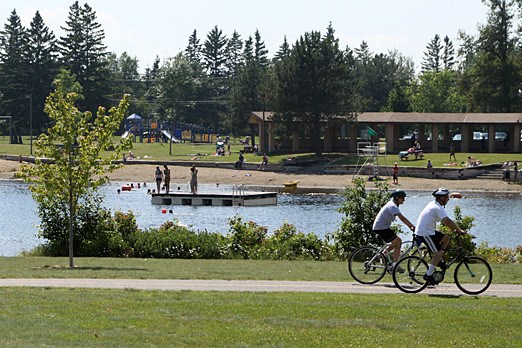THUNDER BAY – The removal of an “impaired” designation from three popular Thunder Bay-area beaches means the public can swim them with more confidence, leaders say.
Thunder Bay’s city council heard an update on the issue at a meeting on Monday.
The step, expected to be approved by provincial and federal governments in the coming months, reflects significant improvements to water quality at the main beach at Boulevard Lake, and the main beach and Sandy Beach at Chippewa Park.
The contamination of those beaches with E. coli, primarily due to waterfowl, had been identified as a Beneficial Use Impairment (BUI) in the 1990s under a government-funded Remedial Action Plan to rehabilitate water quality in the Thunder Bay Area of Concern.
The Remedial Action Plan steering committee announced its recommendation to redesignate the three beaches as “not impaired” last year.
Once approved, that will mean seven of 11 BUIs identified for the Thunder Bay Area of Concern will be resolved.
The Thunder Bay Area of Concern includes around 28 kilometres of Lake Superior shoreline around the city, extending up to nine kilometers offshore and also covering the Thunder Bay watershed.
Remaining BUIs considered impaired in that area include loss of fish and wildlife habitat, degradation of fish and wildlife populations, and degradation of benthos in sediment in the North Harbour. Restrictions on fish and wildlife consumption are another BUI still requiring further assessment.
Those “ecosystem impairments” stemmed from urbanization on the waterfront, industrial and municipal wastewater discharge, hydroelectric development, and heavy industrialization from the pulp and paper industry, RAP coordinator Tim Hollinger told council on Monday.
Coun. Andrew Foulds asked presenters to convey whether the redesignation means residents who have avoided the beaches can now feel safe returning.
“I understand going from ‘impaired to not impaired is a good thing, but in terms of that language, I’m not sure that gives the public a whole lot of confidence,” he said.
“Can we say that Boulevard Lake is safe to swim, and are you confident in making that statement? I know you can’t eliminate risk 100 per cent, but unfortunately Boulevard Lake has got a bad rap.”
Gurpreet Mangat from Environment and Climate Change Canada, who also sits on the RAP steering committee, answered in the affirmative.
“I would say so, because the water quality guideline… has been achieved,” she said. “If we’re staying below that guideline, then the water is okay to swim in, essentially, and the recreational use of the beaches is restored.”
To end the “impaired” designation for the beaches, frequent water quality testing must show E. coli counts regularly meet federal and Ontario guidelines based on a five-year monitoring average.
That objective was met 98 per cent of the time at Chippewa's Sandy Beach, 81 per cent of the time at the main beach, and 93 per cent of the time at Boulevard Lake between 2016 and 2020. Those numbers have shown continuous improvement in recent years, Mangat said.
"From my perspective the beaches in Thunder Bay are safe now," said Hollinger, the RAP coordinator, in an interview. "They have been in the past, but we can say with certainty through these delisting criteria and these guidelines implemented by the federal government and the province that our beaches in Thunder Bay are in very good condition.”
It also must be shown that pollution control plans have been implemented for the beaches.
Hollinger and other presenters pointed to steps taken including drainage improvements, the removal of litter and debris from Boulevard Lake beaches when it was drained, and low impact developments added on the north side of Boulevard Lake.
Foulds expressed his own confidence that Boulevard Lake, which falls within his Current River Ward, is safe.
The Thunder Bay District Health Unit continues to monitor the beaches, and conveys information on water quality online and with permanent swimming advisory signs at beaches.
The RAP committee's recommendation to delist the beach closings BUI will be reviewed by a panel of the The Canada-Ontario Agreement on Great Lakes Water Quality and Ecosystem Health. That process typically takes up to six months, the city said.
Next steps to resolve other BUIs in the Thunder Bay RAP include the development of a habitat strategy to rehabilitate animal habitats through strategies like reforestation of riparian areas.
